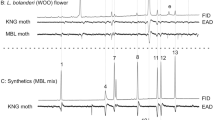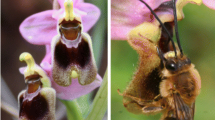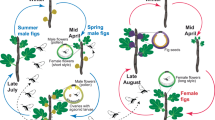Abstract
We investigated patterns of volatiles of several allopatric and sympatric species of the Ophrys fusca group and one species of the O. mammosa/sphegodes group pollinated by either Andrena nigroaenea or A. flavipes, using electrophysiology (gas chromatography coupled with electroantennography; GC-EAD) and chemical analyses. We found 52 GC-EAD active compounds, mainly saturated and unsaturated hydrocarbons with chain lengths of 21 to 31, aldehydes, an ester, and an acid. Based on the relative proportions of all GC-EAD active compounds, the investigated species were compared using various statistical methods (ANOVA, principle component analyses, discriminant function analyses and cluster analyses). Our results show that Ophrys species with the same pollinator – independent of their phylogenetic relationship–use the same volatiles for pollinator attraction. Differences between the species mainly involve different quantitative patterns of volatiles. Our results are in congruence with previous studies that showed different odour bouquets to be responsible for the specific attraction of different pollinators and that alkanes and alkenes are most important for pollinator attraction.
Similar content being viewed by others
Author information
Authors and Affiliations
Rights and permissions
About this article
Cite this article
Stökl, J., Paulus, H., Dafni, A. et al. Pollinator attracting odour signals in sexually deceptive orchids of the Ophrys fusca group. Plant Syst. Evol. 254, 105–120 (2005). https://doi.org/10.1007/s00606-005-0330-8
Received:
Accepted:
Published:
Issue Date:
DOI: https://doi.org/10.1007/s00606-005-0330-8




